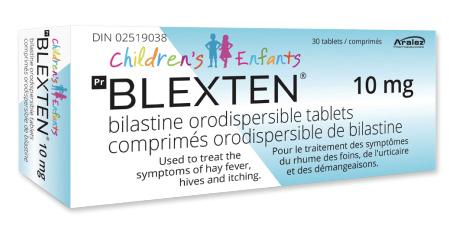
7 minute read
Still using fax to receive prescriptions? You may as well be using messenger pigeons.
from PPB-Jan/Feb 2023
by ensembleiq
Stop using last century’s technology for prescriptions. Evolve to true e-prescribing with PrescribeIT®. It integrates directly into your pharmacy management system and protects patient privacy. No more transmission failures, and no more back and forth phone calls and faxes to clarify prescriptions. Enjoy the benefits of enhanced medication safety. Learn more at PrescribeIT.ca
Prescription antihistamine for seasonal allergic rhinitis and chronic spontaneous urticaria
About For Children And Adults
BLEXTEN Oral Solution
• Raspberry flavour in a clear, colourless liquid 2.5 mg/mL oral solution
• Standard dose of 10 mg (4 mL)
• No weight calculation required
• Includes 4 mL dosing cup
What is the recommended dosing for BLEXTEN?
Ages 4–11 (with a body weight of at least 16 kg) 10 mg (1 ODT or 4 mL oral solution) once daily1
• No weight calculations needed for pediatric dosing.
Now available in pediatric formats
What is BLEXTEN indicated for?
PrBLEXTEN® (bilastine) is indicated for the symptomatic relief of nasal and non-nasal symptoms of seasonal allergic rhinitis (SAR) in patients 4 years of age and older with a body weight of at least 16 kg.1
BLEXTEN is indicated for the relief of the symptoms associated with chronic spontaneous urticaria (CSU) (e.g. pruritus and hives), in patients 4 years of age and older with a body weight of at least 16 kg.1


What are the new pediatric formats?
BLEXTEN now offers flexibility and convenience with a pediatric dose in 2 formats. The pediatric formats are suitable for children 4-11 years old with a body weight of at least 16 kg.1
BLEXTEN Orodispersible Tablets (ODT)
• Grape flavour, dye-free
• 10 mg tablet
• Rapidly disperses in the mouth so it can be easily swallowed
• Convenient tablet formulation that can be taken without water
Ages 12+ 20 mg tablet once daily1
Counselling tips for parents
• If it is difficult to ensure that your child does not eat anything for one hour after taking BLEXTEN, try administering it before bedtime.

• The ODT format is a good option for older children who may be able to manage their own schedule. It is easily portable for school, sports activities and travel.
• As COVID mask mandates are relaxed, it is normal that people may feel nervous when they are around anyone who exhibits symptoms, like allergy symptoms, that can be similar to COVID. Help your child understand this scenario, and let them know that it’s ok to tell people that they have allergies and they are not contagious.
How effective was BLEXTEN in clinical trials for seasonal allergic rhinitis?
BLEXTEN demonstrated similar efficacy compared to cetirizine and desloratadine for the total symptom score (TSS) area under the curve (AUC) in two clinical trials for seasonal allergic rhinitis. 2,3
BLEXTEN vs cetirizine†
• No dose adjustments needed for elderly patients, kidney disease or liver disease.1
Administraton1
• BLEXTEN should be taken without food or grapefruit juice or other fruit juices, as these dietary compounds may decrease the effect of bilastine.
• The BLEXTEN ODT is to be placed in the mouth where it disperses rapidly in saliva, so it can be easily swallowed. Alternatively, the ODT may be dispersed in water before administration. Grapefruit juice or any other fruit juice should not be used for dispersion.
• Patients should be instructed to take BLEXTEN and wait for one hour before taking food or fruit juice; or if food or fruit juice has been taken to wait for two hours before taking the tablet.
The maximum daily dose for pediatrics (ages 4-11) is 10 mg (1 orodispersible tablet or 4 mL oral solution); for ages ≥12, the maximum daily dose is 20 mg (1 tablet).
See the Product Monograph for complete dosing and administration information.
• BLEXTEN 20 mg significantly reduced the TSS AUC vs placebo (p<0.001).1,2
There was no significant difference between BLEXTEN and cetirizine on the TSS AUC from baseline to the end of the study (Day 14). 2
No difference between bilastine vs. cetirizine
Adapted from Kuna, et al 2
† Double-blind, placebo-controlled, randomized, active-controlled parallel-group trial of 678 patients with SAR, 12-69 years old. Patients were randomized to BLEXTEN 20 mg, cetirizine 10 mg or placebo once daily for 14 days. Primary endpoint was change in AUC of the TSS from baseline to day 14. TSS was comprised of the reflective total nasal symptom score (rTNSS) and the reflective total non-nasal symptom score (rTNNSS).
Somnolence and fatigue were significantly decreased with BLEXTEN vs. cetirizine2
No di erence between BLEXTEN vs. placebo
Adapted from Kuna, et al 2 BLEXTEN vs desloratadine‡
• BLEXTEN 20 mg significantly reduced the TSS AUC vs placebo (p<0.001).1,3
• There was no significant difference between BLEXTEN and desloratadine on the TSS AUC from baseline to the end of the study (Day 14).3
No difference between bilastine vs. desloratadine demonstrated that: o The systemic exposure with 10 mg bilastine in children from 4 to 11 years is equivalent to the exposure in adults with 20 mg bilastine.
• The extrapolation from adult and adolescent data is deemed appropriate for this product as the pathophysiology of allergic rhinitis and urticaria is the same for all age groups. What is the safety profile for BLEXTEN? BLEXTEN has a demonstrated safety profile and was well tolerated in children and adults.
Pediatric adverse events similar to placebo1§ Related treatment-emergent adverse reactions reported in ≥1% of subjects treated with BLEXTEN 10 mg ODT in the pediatric studies
The adverse event profile in the open-label, 1-year follow-up study in 513 patients was similar to that observed in the controlled 2-4 week Phase 2 and 3 clinical studies.
Psychomotor performance1
• BLEXTEN did not affect psychomotor performance in clinical trials at doses of up to 40 mg once daily, and did not affect driving performance in a standard driving test.
• The psychomotor performance after concomitant intake of alcohol and BLEXTEN was similar to that observed after intake of alcohol and placebo.
Driving performance1
• BLEXTEN did not affect driving performance differently than placebo following day one or after one week of treatment, in a study assessing the effects of BLEXTEN 40 mg on real time driving performance compared to placebo and hydroxyzine 50 mg.
• Patients should be informed, however, that very rarely some people experience drowsiness, which may affect their ability to drive or use machines.
Metabolism1
• BLEXTEN is not significantly metabolized. It does not induce or inhibit activity of CYP450 isoenzymes in in vitro and in vivo studies. See the Product Monograph for complete safety information.
Adult adverse events equal to placebo1
Treatment-emergent adverse reactions reported in ≥1% of subjects treated with BLEXTEN 20 mg in Phase 2 and 3 trials
Adapted from Bachert C, et al 3
Efficacy in children1
The efficacy of bilastine has been studied in adults and adolescents.
• According to guidelines, the proven efficacy in adults and adolescents for seasonal allergic rhinitis can be extrapolated to children, having
Clinical use:
BLEXTEN should not be administered to children below 4 years of age and under 16 kg due to limited data in this population.
Contraindication:
• History of QT prolongation and/or torsade de pointes, including congenital long QT syndromes.
Relevant warnings and precautions:
• QTc interval prolongation, which may increase the risk of torsade de pointes.
Use with caution in patients with a history of cardiac arrhythmias; hypokalemia, hypomagnesaemia; significant bradycardia; family history of sudden cardiac death; concomitant use of other QT/QTcprolonging drugs.
• P-glycoprotein inhibitors may increase plasma levels of BLEXTEN in patients with moderate or severe renal impairment; co-administration should be avoided.
BLEXTEN should be avoided during pregnancy unless advised otherwise by a physician.
• A study was performed to assess the effects of BLEXTEN and bilastine 40 mg on real time driving performance compared to placebo. Bilastine did not affect driving performance differently than placebo following day one or after one week of treatment. However, patients should be informed that very rarely some people experience drowsiness, which may affect their ability to drive or use machines.
For more information:
Please consult the product monograph at www. miravohealthcare.com/wp-content/uploads/2021/08/ Blexten-PM-ENG-Aug2021.pdf for important information relating to adverse reactions, drug interactions, and dosing information which have not been discussed in this piece. The product monograph is also available by calling 1-866-391-4503.
‡ Double-blind, placebo-controlled, randomized, activecontrolled parallel-group trial of 720 patients with SAR, 12-70 years old. Patients were randomized to BLEXTEN 20 mg, desloratadine 5 mg or placebo once daily for 14 days. Primary endpoint was change in AUC of the TSS from baseline to day 14. TSS was comprised of the reflective total nasal symptom score (rTNSS) and the reflective total nonnasal symptom score (rTNNSS).
§ Assessed in 291 children 2-11 years of age who were treated for allergic rhinoconjunctivitis or chronic spontaneous
What is the worldwide patient exposure for BLEXTEN?*
BLEXTEN 10 mg
• More than 2.2 million patients treated over 4 years
• Approved in 58 countries
• Pediatric formats available in Canada since February 2022
BLEXTEN 20 mg
• More than 213 million patients treated over 10 years
• Approved in 121 countries
• Approved in Canada for 5 years urticaria in a 12-week controlled clinical trial; 260 were exposed in the clinical study and 31 in the pharmacokinetic study. BLEXTEN is indicated in children 4 years of age and older and at least 16 kg.
BLEXTEN is covered under most private healthcare plans.
* As of August 31, 2021, the estimate from internal data of patient exposure is based on units sold of the defined daily dose of 10 mg (pediatric) and 20 mg (adult) bilastine and the mean treatment duration of 3 weeks.
References
1. Blexten Product Monograph. Aralez Pharmaceuticals Canada Inc. 2021. 2. Kuna P, Bachert C, Nowacki A, et al. Efficacy and safety of bilastine 20 mg compared with cetirizine 10 mg and placebo for the symptomatic treatment of seasonal allergic rhinitis: a randomized, double-blind, parallel-group study. Clinical & Experimental Allergy. 2009;39(9):1338-1347. 3. Bachert C, Kuna P, Sanquer F, et al. Comparison of the efficacy and safety of bilastine 20 mg vs desloratadine 5 mg in seasonal allergic rhinitis patients. Allergy. 2009;64(1):158-165.
Aralez Pharmaceuticals Canada Inc.* 6733 Mississauga Road, Suite 800, Mississauga, Ontario L5N 6J5
*d/b/a Miravo Healthcare
BLEXTEN is a registered trademark of FAES used under license by Aralez Pharmaceuticals Canada Inc.








